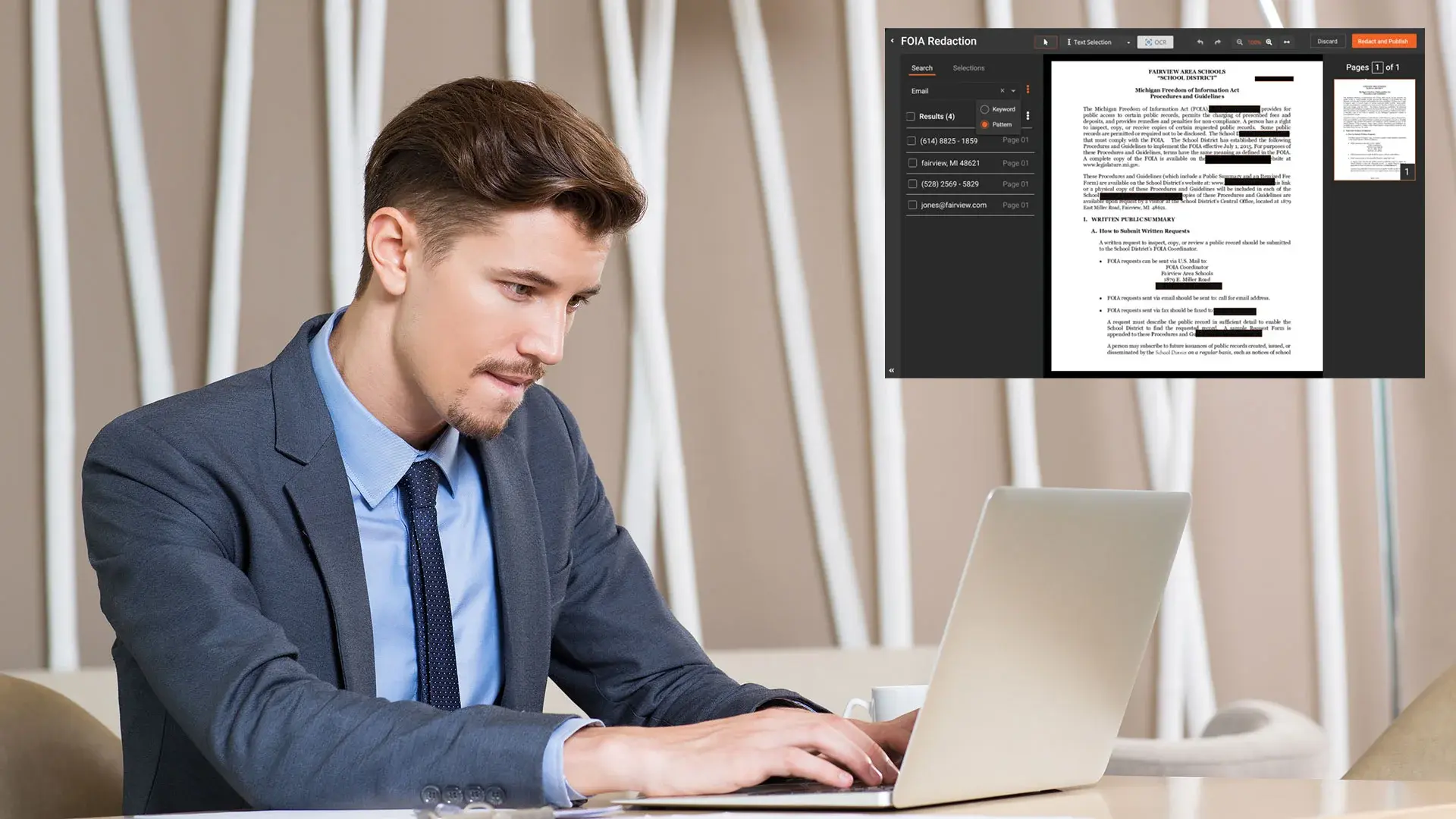Document Redaction for FOIA Requests with FOIA Redaction Software
by Moazzam Iqbal, Last updated: June 23, 2025, Code:

The Freedom of Information Act (FOIA) grants the public the right to request certain records from the federal government. Explore how to respond to FOIA requests in a timely manner with document redaction using FOIA redaction software.
In FY 2023, 1,199,699 FOIA requests were submitted to 121 public institutions, marking an all-time high public demand for government transparency. This request surge presents a formidable challenge: How can schools efficiently process this growing volume while meticulously safeguarding sensitive information?
The FOIA is designed to promote transparency and accountability in government by making government records accessible to the public upon request. It also defines which requested documents are subject to release, outlines mandatory disclosure procedures, and includes nine exemptions to the statute that protect sensitive data, such as national security issues.
Public educational institutions now face the dual challenge of locating and reviewing documents while carefully redacting exempt information, such as financial details, personal data, and privileged communications. Traditional and manual redaction approaches are time-consuming, prone to human error, and costly in terms of resources.
What Is a FOIA Request and Who Can Submit One?
FOIA requests are submissions made to public education institutions seeking access to records held by them on various topics.
According to the act, FOIA requests must be responded to within 20 working days unless an extension is granted due to exceptional circumstances.
How FOIA and Public Records Laws Apply to Schools and Universities
Publicly funded educational institutions are subject to public records requests under FOIA or their state’s equivalent law. This includes:
- Student enrollment and discipline data
- Financial reports and meeting minutes
- Staff salaries and contracts
- Email communications by officials
However, these institutions must also comply with FERPA, which mandates the redaction of personally identifiable student information (PII) before any public disclosure.
Failure to properly redact student data can result in FERPA violations, leading to reputational damage, funding loss, and legal penalties.
As the workload grows annually, all kinds of public educational institutions encounter numerous challenges in efficiently and cost-effectively managing FOIA requests.
What Challenges Does Public Education Face in FOIA Request Redaction?
School districts frequently face challenges when responding to various FOIA requests. However, their ability to effectively address these obstacles often hinders their progress.
Several factors contribute to the potential delays in the response from school districts. Some of the most common challenges include:
- FOIA requests require meticulous record reviewing to determine relevancy—a time-consuming process.
- Multiple documents require redaction with the high volume of FOIA requests.
- Redacting personally identifiable information (PII), protected health information (PHI), and the data protected from disclosure under FOIA's nine exceptions.
- Deciding which documents can be released publicly.
In addition to the complexity of the response process for FOIA requests, other hurdles include allocating sufficient resources, managing associated expenses, and ensuring compliance with various laws and policies.
By addressing these challenges, schools can strive to enhance their responsiveness and improve the efficiency of handling FOIA requests.
What Happens If FOIA Redaction Fails?
Under the Privacy Act of 1974, as well as other data privacy regulations such as HIPAA in healthcare and FERPA in education, records containing personal identifiers must be safeguarded to prevent unauthorized access. Failure to redact sensitive information can lead to severe consequences:
- FERPA violations: Inadequate redaction of student data may lead to FERPA non-compliance, risking federal funding or disciplinary action from the U.S. Department of Education.
- Breach of student trust: Exposing student grades, medical records, or disciplinary actions can result in lawsuits, parental backlash, and loss of public confidence.
- Data breach liability: Inadequate document redaction can result in the disclosure of personal information, exposing the FOIA request processor to liability damages or financial losses.
- Reputational harm: Beyond legal and financial repercussions, public instiutions may suffer reputational damage due to mishandled redaction.
Prioritizing proper document redaction for FOIA requests is vital across federal departments to ensure the confidentiality of Personal Identifiable Information (PII).
Why Is Efficient FOIA Redaction Essential for Compliance?
Document redaction plays a crucial role in responding to FOIA requests, concealing sensitive information before making it publicly available or sharing it. However, the manual document redaction process can be extremely time-consuming.
For example, a school district may receive a public records request for school board emails related to student discipline policies. Before releasing those emails, administrators must ensure that no student names, medical information, or identifying details are visible—making redaction a critical compliance step.
The sheer magnitude of the task does not negate the importance of conducting a thorough review. Even a single oversight that exposes confidential or privileged information could have disastrous consequences. It is imperative, especially in the modern age, to meet legal regulations such as FERPA, HIPAA, and FOIA exemptions.
So, how can you efficiently locate and conceal sensitive information within your dataset manually?
The answer is that you don't have to do it manually, at least not anymore.
Employing advanced techniques and an automated FOIA redaction tool can simplify the process of document redaction for FOIA requests, saving time and ensuring accuracy in handling them.
How FOIA Redaction Software Automates Compliance & Saves Time
Advanced and automated FOIA redaction software like VIDIZMO Redactor helps streamline the FOIA request-response process by leveraging automation and AI capabilities.
This eliminates the need for manual redaction, reduces the risk of errors and exposure to sensitive data, and addresses many other challenges faced by educational institutes.
Automatic Document Redaction
The advent of AI technology has revolutionized how departments handle FOIA requests. By implementing automated redaction solutions, your school can alleviate stress, reduce operational costs, and enhance public response times.
VIDIZMO's AI Redaction Software offers a user-friendly tool with a simple and intuitive interface. With this software, anyone can swiftly identify and highlight sensitive information, seamlessly replacing it with solid boxes to render it invisible.
With advanced techniques such as keyword searching and custom pattern detection to identify various types of sensitive information, the process of document redaction for FOIA requests is automated. This enables school districts to respond more promptly and accurately to FOIA requests.
To dive deeper into the topic of document redaction and explore the tools that can enhance this process, we invite you to check out our complete guide to FOIA-compliant redaction best practices for public schools.
Bulk Document Redaction
The bulk redaction feature provides a comprehensive solution for document redaction, enabling schools to handle large volumes of sensitive information efficiently.
School departments frequently face scenarios where extensive PDF files need to be carefully redacted before release. With VIDIZMO's bulk redaction feature, they can swiftly identify and redact confidential details from multiple documents simultaneously.
This streamlined process not only reduces effort but also minimizes the risk of unintentionally disclosing sensitive data.
Public institutes can enhance their redaction workflow by utilizing the bulk redaction feature, ensuring the secure handling of sensitive information.
OCR-enabled Redaction Technology
By harnessing the power of AI, Optical Character Recognition (OCR) capabilities can automatically detect and identify text from scanned documents, low-quality documents, and images. This means FOIA officers no longer need to manually redact text from poor-quality scans or image-based files—OCR ensures nothing is missed, even in difficult formats.
AI-Enhanced Search for Large Data Volumes
With the vast amounts of data public schools must process for FOIA requests, locating specific documents or pinpointing sensitive information to redact can be an overwhelming task. Traditional search methods are often inefficient, especially within large document libraries.
AI-enhanced search capabilities of automated FOIA redaction tool allow parties to search both within documents and across extensive document repositories quickly.
This helps streamline document redaction for FOIA requests by identifying relevant content, significantly reducing manual effort and enhancing overall efficiency.
Automated Translation for FOIA Requests in Multiple Languages
Automated translation helps school districts handle FOIA requests involving documents in various languages by quickly translating content into the required language.
This ensures sensitive information in foreign languages is identified and redacted, streamlining the process and maintaining compliance across documents with an automated FOIA redaction tool.
Key Takeaways
-
Efficient FOIA Response: FOIA redaction software streamlines the document review and redaction process, ensuring that schools can respond to FOIA requests quickly while maintaining compliance with legal regulations.
-
Automation Reduces Human Error: Automated FOIA redaction tools, powered by AI and machine learning, significantly reduce the risk of human error and make the redaction process faster and more accurate, especially when handling large volumes of data.
-
Compliance with Privacy Regulations: Redacting sensitive information such as Personally Identifiable Information (PII), Protected Health Information (PHI), and national security data is essential for complying with regulations like the Privacy Act, HIPAA, and FOIA exemptions.
-
Bulk Redaction Saves Time: The ability to redact multiple documents at once using bulk redaction tools saves schools considerable time, ensuring that sensitive information is efficiently protected across large datasets.
-
OCR and AI-Enhanced Search for Efficiency: AI technologies, including Optical Character Recognition (OCR) and enhanced search functionalities, help agencies quickly identify and redact sensitive information within scanned or image-based documents, enhancing workflow efficiency.
-
Multilingual Translation Support: Automated translation capabilities enable schools to handle FOIA requests involving documents in various languages, ensuring sensitive information in foreign languages is also appropriately redacted.
-
Risk Mitigation and Legal Protection: Using FOIA redaction software mitigates the risk of data breaches, reputational harm, and legal consequences by safeguarding sensitive data and ensuring compliance with data privacy regulations.
You can cut FOIA processing time by 70% with VIDIZMO’s Redactor.
Respond to FOIA Requests with VIDIZMO FOIA Redaction Software
In summary, document redaction for FOIA requests plays a crucial role in enabling public educational institutes to protect sensitive information while efficiently responding to FOIA requests.
VIDIZMO simplifies the redaction process with its advanced capabilities of FOIA redaction software, including automatic redaction, custom pattern search, bulk redaction, OCR, AI-enhanced search as well as multilingual translation capabilities. By embracing this smart technology, school districts can streamline the redaction process and minimize human error.
People Also Ask
What is document redaction for FOIA requests?
Document redaction for FOIA requests involves reviewing and removing sensitive information from documents before they are disclosed in response to a FOIA request. This is done to protect personal, confidential, or classified data, ensuring compliance with legal regulations such as the Privacy Act and various exemptions under FOIA.
Why is redacting sensitive information in FOIA requests important?
Redacting sensitive information in FOIA requests is crucial to prevent the unauthorized disclosure of personal data, national security details, and other protected information. Failure to redact these details can result in legal penalties, data breaches, and damage to an organization's reputation.
What information must be redacted in FOIA documents?
FOIA documents must redact PII, PHI, and classified info—anything protected under the nine FOIA exemptions. In schools, this includes student names, ID numbers, grades, IEPs, disciplinary history, or any data protected under FERPA.
How does FOIA redaction software work?
FOIA redaction software uses AI and machine learning to automatically identify and remove sensitive data from documents. It scans the document for personal information or confidential content and applies redaction, making the content safe for public release while ensuring compliance with privacy regulations.
What are the benefits of using automated FOIA redaction software?
Using automated FOIA redaction software enhances efficiency, reduces human error, and speeds up the response process. It allows public schools to handle large volumes of requests accurately and in compliance with legal standards, while maintaining the confidentiality of sensitive data.
Can FOIA redaction software process large volumes of documents?
Yes, FOIA redaction software can process large volumes of documents efficiently. It is designed to handle extensive datasets quickly, allowing public schools to redact multiple documents at once, ensuring faster response times to FOIA requests and minimizing the risk of errors.
What are the challenges faced when manually redacting FOIA documents?
Manual redaction of FOIA documents is time-consuming, prone to human error, and labor-intensive, especially when dealing with large volumes of documents. The need for meticulous reviewing, identifying sensitive information, and applying redaction can lead to delays and inefficiency, complicating the response process.
How can AI improve FOIA redaction efficiency?
AI can significantly improve FOIA redaction efficiency by automatically detecting and redacting sensitive data, such as PII or confidential government information. It uses natural language processing and pattern recognition to identify key data points, reducing the manual effort required and increasing accuracy.
What is bulk redaction in FOIA requests?
Bulk redaction in FOIA requests refers to the process of redacting multiple documents at once. This feature helps streamline the redaction process for public schools by allowing them to quickly identify and redact sensitive information across numerous files simultaneously, saving time and reducing manual labor.
How does OCR technology assist in FOIA redaction?
Optical Character Recognition (OCR) technology helps identify and redact sensitive information in scanned documents or images. OCR converts text in images into machine-readable format, allowing FOIA redaction software to detect and obscure any confidential content, ensuring compliance with privacy laws.
Jump to
You May Also Like
These Related Stories

State FOI Laws and How FOIA Redaction Software Helps You Comply

How to Follow FOIA Rules Using FOIA Redaction Software



No Comments Yet
Let us know what you think